F1-4.20-27
- 格式:pdf
- 大小:369.98 KB
- 文档页数:5
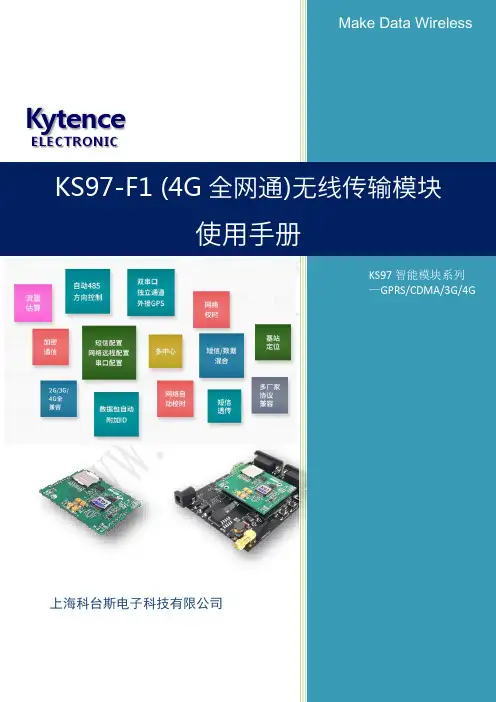
KS97-F1 (4G)KytenceELECTRONICKS97智能模块系列 —GPRS/CDMA/3G/4GMake Data Wireless上海科台斯电子科技有限公司目录1. 功能简介 (5)2. 产品外观图 (6)3. 技术规格 (8)4. 应用说明 (9)4.1 参数配置 (9)4.2 短信(命令)/数据混合模式 (9)4.3 网络完全透传模式 (10)4.4 上行数据自动附加设备ID (10)4.5 查询无线信号强度 (10)4.6 查询IMEI (10)4.7 基站定位功能 (10)4.8 短信查询调试信息 (11)4.9 短信透传模式 (11)4.10多中心模式/多备份模式 (11)4.11双串口应用模式 (11)4.12网络校时功能* (12)4.13查询数据流量* (12)4.14加密通信 (12)4.15服务器工作模式* (12)4.16型应用电路1(单串口/双串口) (13)4.17典型应用电路2(RS485控制) (13)4.18电源电路参考1(简易5V供电) (14)4.19电源电路参考2(5-40V输入范围 DC/DC供电) (14)4.20电源电路参考3(5-12V输入范围线性稳压供电) (14)4.21外置SIM卡电路 (15)5. 安装/运行 (16)5.1 KS97 EVB介绍 (16)5.2 天线及 SIM(UIM)卡安装 (16)5.3 用户数据接口和电源电缆安装 (16)5.4 配件 (17)5.5 配置设备参数 (17)5.6 设备上电运行 (17)5.7 联网故障分析 (17)6. 产品参数配置 (19)6.1 准备 (19)6.2 软件界面说明 (20)6.2.1 界面概述 (20)6.2.2 设备串口参数配置 (20)6.2.3 网络参数设置 (21)6.2.4 传输参数设置 (22)6.2.5 多中心传输模式设置 (23)6.2.6 号码授权/密码授权设置 (23)6.3 保存 (24)6.4 批量配置模式 (24)6.5 短信命令生成工具 (24)6.6 短信配置参数/收发数据 (25)6.7 服务器远程配置参数 (25)7. 功能测试举例 (26)7.1 产品测试过程举例(无协议透传模式) (26)7.1.1 准备工作: (26)7.1.2 配置设备参数: (26)7.1.3 打开<网络调试助手.exe> 和 <串口调试助手.exe> (27)7.1.4 重新上电,等待设备连接服务器 (27)7.2 短信功能的测试 (29)7.2.1 设备向手机发送短信 (29)7.2.2 手机向设备发短信 (29)附录1:诊断信息说明 (31)附录2:路由器中IP的设置 (33)附录3: MIX版本(默认版本)使用说明 (35)1.MIX混合版本定义 (35)2.数据/命令的区分 (35)3.配置命令列表 (35)4.短信命令 (35)4.1 短信发送命令 (35)4.2 AT+SMS命令应答控制 (37)4.3 仅做短信模块使用 (37)附录4:AT+DNS说明及设置方法 (38)附录5:常见问题 (39)1.功能简介KS97-F1 4G全网通嵌入式模组针对仪器仪表/自动化产品而设计,采用插针式结构,使得用户产品无需更改软件,即可在最短时间内获得高效稳定的全制式兼容的蜂窝网络数据通信功能或短信通信功能。
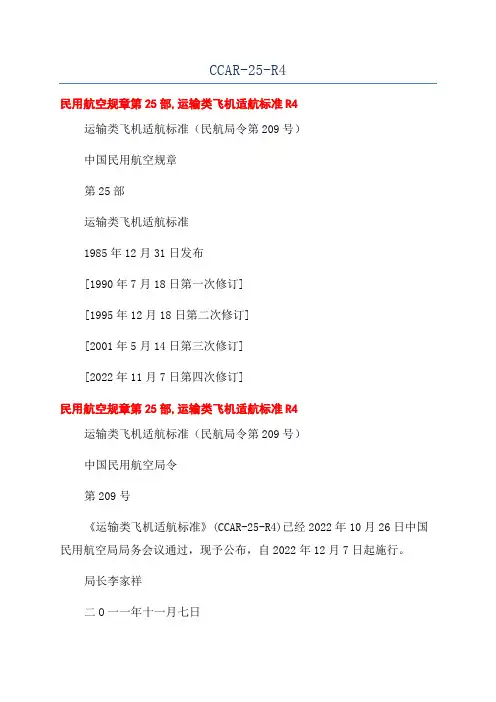
CCAR-25-R4民用航空规章第25部,运输类飞机适航标准R4运输类飞机适航标准(民航局令第209号)中国民用航空规章第25部运输类飞机适航标准1985年12月31日发布[1990年7月18日第一次修订][1995年12月18日第二次修订][2001年5月14日第三次修订][2022年11月7日第四次修订]民用航空规章第25部,运输类飞机适航标准R4运输类飞机适航标准(民航局令第209号)中国民用航空局令第209号《运输类飞机适航标准》(CCAR-25-R4)已经2022年10月26日中国民用航空局局务会议通过,现予公布,自2022年12月7日起施行。
局长李家祥二O一一年十一月七日中国民用航空局民用航空规章第25部,运输类飞机适航标准R4运输类飞机适航标准(民航局令第209号)目录A分部总则............................................................. ............................................................... .. (1)第25.1条适用范围............................................................. .................................................1第25.2条[备用]............................................................ .......................................................1第25.3条ETOPS型号设计批准的专用条款............................................................. (1)B分部飞行............................................................. ............................................................... .. (1)总则............................................................. ............................................................... ...............1第25.21条证明符合性的若干规定............................................................. .......................1第25.23条载重分布限制............................................................. .......................................2第25.25条重量限制............................................................. ...............................................2第25.27条重心限制............................................................. ...............................................3第25.29条空重和相应的重心............................................................. ...............................3第25.31条可卸配重............................................................. ...............................................3第25.33条螺旋桨转速和桨距限制............................................................. .. (3)性能............................................................. ............................................................... ...............3第25.101条总则............................................................. .....................................................3第25.103条失速速度............................................................. .............................................5第25.105条起飞............................................................. .....................................................6第25.107条起飞速度............................................................. .............................................6第25.109条加速—停止距离............................................................. .................................8第25.111条起飞航迹............................................................. ...........................................10第25.113条起飞距离和起飞滑跑距离............................................................. ...............11第25.115条起飞飞行航迹................................................................................................11第25.117条爬升:总则............................................................. .......................................11第25.119条着陆爬升:全发工作............................................................. .......................12第25.121条爬升:单发停车............................................................. ...............................12第25.123条航路飞行航迹............................................................. ...................................13第25.125条着陆............................................................. (13)操纵性和机动性............................................................. ........................................................15第25.143条总则............................................................. ...................................................15第25.145条纵向操纵............................................................. ...........................................16第25.147条航向和横向操纵............................................................. ...............................17第25.149条最小操纵速度............................................................. .. (18)配平.............................................................. ................................................................ ...........20第25.161条配平.............................................................. .. (20)稳定性............................................................. ............................................................... .........21第25.171条总则............................................................. ...................................................21第25.173条纵向静稳定性............................................................. ...................................21第25.175条纵向静稳定性的演示............................................................. .......................21第25.177条横向和航向静稳定性............................................................. .. (22)民用航空规章第25部,运输类飞机适航标准R4运输类飞机适航标准(民航局令第209号)第25.181条动稳定性............................................................. . (23)失速............................................................. ............................................................... . (23)第25.201条失速演示............................................................. ...........................................23第25.203条失速特性............................................................. ...........................................24第25.205条[删除]............................................................失速警告............................................................. . (24)地面和水面操纵特性............................................................. ................................................25第25.231条纵向稳定性和操纵性............................................................. .......................25第25.233条航向稳定性和操纵性............................................................. .......................25第25.235条滑行条件............................................................. ...........................................26第25.237条风速............................................................. ...................................................26第25.239条水面喷溅特性、操纵性和稳定性............................................................. (26)其它飞行要求............................................................. (27)第25.251条振动和抖振............................................................. .......................................27第25.253条高速特性............................................................. ...........................................27第25.255条失配平特性............................................................. (28)C分部结构............................................................. (29)总则............................................................. ............................................................... .............29第25.301条载荷............................................................. ...................................................29第25.303条安全系数............................................................. ...........................................29第25.305条强度和变形............................................................. .......................................29第25.307条结构符合性的证明............................................................. (29)飞行载荷.............................................................. ................................................................ ...30第25.321条总则.............................................................. .. (30)飞行机动和突风情况............................................................. ................................................30第25.331条对称机动情况............................................................. ...................................30第25.333条飞行机动包线................................................................................................31第25.335条设计空速............................................................. ...........................................32第25.337条限制机动载荷系数............................................................. ...........................33第25.341条突风和紊流载荷............................................................. ...............................34第25.343条设计燃油和滑油载重............................................................. .......................35第25.345条增升装置............................................................. ...........................................35第25.349条滚转情况............................................................. ...........................................36第25.351条偏航机动情况............................................................. .. (36)补充情况............................................................. ............................................................... .....37第25.361条发动机扭矩............................................................. .......................................37第25.363条发动机和辅助动力装置支架的侧向载荷....................................................37第25.365条增压舱载荷............................................................. .......................................37第25.367条发动机失效引起的非对称载荷............................................................. .......38第25.371条陀螺载荷............................................................. ...........................................38第25.373条速度控制装置............................................................. .. (39)操纵面和操纵系统载荷............................................................. .. (39)民用航空规章第25部,运输类飞机适航标准R4运输类飞机适航标准(民航局令第209号)第25.391条操纵面载荷:总则............................................................. ...........................39第25.393条平行于铰链线的载荷............................................................. .......................39第25.395条操纵系统............................................................. ...........................................39第25.397条操纵系统载荷............................................................. ...................................39第25.399条双操纵系统............................................................. .......................................40第25.405条次操纵系统............................................................. .......................................40第25.407条配平调整片的影响............................................................. ...........................41第25.409条调整片............................................................. ...............................................41第25.415条地面突风情况............................................................. ...................................41第25.427条非对称载荷............................................................. .......................................42第25.445条辅助气动力面................................................................................................42第25.457条襟翼............................................................. ...................................................43第25.459条特殊装置............................................................. . (43)地面载荷.............................................................. ................................................................ ...43第25.471条总则.............................................................. ..................................................43第25.473条着陆载荷情况和假定.............................................................. ......................43第25.477条起落架布置.............................................................. ......................................44第25.479条水平着陆情况.............................................................. ..................................44第25.481条尾沉着陆情况.............................................................. ..................................44第25.483条单起落架着陆情况.............................................................. ..........................45第25.485条侧向载荷情况.............................................................. ..................................45第25.487条回跳着陆情况................................................................................................45第25.489条地面操纵情况.............................................................. ..................................45第25.491条滑行、起飞和着陆滑跑.............................................................. ..................45第25.493条滑行刹车情况.............................................................. ..................................46第25.495条转弯.............................................................. ..................................................46第25.497条尾轮侧偏.............................................................. ..........................................46第25.499条前轮侧偏与操纵.............................................................. ..............................47第25.503条回转.............................................................. ..................................................47第25.507条倒行刹车.............................................................. ..........................................47第25.509条牵引载荷.............................................................. ..........................................47第25.511条地面载荷:多轮起落架装置上的非对称载荷............................................49第25.519条顶升置.............................................................. (50)水载荷............................................................. ............................................................... .........50第25.521条总则............................................................. ...................................................50第25.523条设计重量和重心位置............................................................. .......................50第25.525条载荷的假定............................................................. .......................................50第25.527条船体和主浮筒载荷系数............................................................. ...................51第25.529条船体和主浮筒着水情况............................................................. ...................51第25.531条船体和主浮筒起飞情况............................................................. ...................52第25.533条船体和主浮筒底部压力............................................................. ...................52第25.535条辅助浮筒载荷............................................................. .. (53)民用航空规章第25部,运输类飞机适航标准R4运输类飞机适航标准(民航局令第209号)第25.537条水翼载荷............................................................. . (54)况............................................................. (54)第25.561条总则............................................................. ...................................................54第25.562条应急着陆动力要求............................................................. ...........................55第25.563条水上迫降的结构要求............................................................. .. (56)疲劳评定............................................................. ............................................................... .....56第25.571条结构的损伤容限和疲劳评定............................................................. .. (56)闪电防护............................................................. ............................................................... .....58第25.581条闪电防护............................................................. ...........................................58D分部设计与构造............................................................. (58)总则............................................................. ............................................................... .............58第25.601条总则............................................................. ...................................................58第25.603料............................................................. ...................................................58第25.605条制造方法............................................................. ...........................................58第25.607条紧固件............................................................. ...............................................59第25.609条结构保护............................................................. ...........................................59第25.611条可达性措施............................................................. .......................................59第25.613条材料的强度性能和材料的设计值............................................................. ...59第25.615条[删除]........................................................... .............................................60第25.619条特殊系数............................................................. ...........................................60第25.621条铸件系数............................................................. ...........................................60第25.623条支承系数............................................................. ...........................................61第25.625条接头系数............................................................. ...........................................61第25.629条气动弹性稳定性要求............................................................. .......................61第25.631条鸟撞损伤............................................................. . (62)面............................................................. ............................................................... .........63第25.651条强度符合性的证明............................................................. ...........................63第25.655条安装............................................................. ...................................................63第25.657条铰链............................................................. (63)操纵系统............................................................. ............................................................... .....63第25.671条总则............................................................. ...................................................63第25.672条增稳系统及自动和带动力的操纵系统........................................................64第25.673条[删除]............................................................ .................................................64第25.675条止动器............................................................. ...............................................64第25.677条配平系统............................................................. ...........................................64第25.679条操纵系统突风锁............................................................. ...............................65第25.681条限制载荷静力试验............................................................. ...........................65第25.683条操作试验............................................................. ...........................................65第25.685条操纵系统的细节设计............................................................. .......................65第25.689条钢索系统............................................................. ...........................................65第25.693条关节接头............................................................. ...........................................66第25.697条升力和阻力装置及其操纵器件............................................................. . (66)民用航空规章第25部,运输类飞机适航标准R4运输类飞机适航标准(民航局令第209号)第25.699条升力和阻力装置指示器............................................................. ...................66第25.701条襟翼与缝翼的交连............................................................. ...........................66第25.703条起飞警告系统............................................................. .. (67)起落架............................................................. ............................................................... .........67第25.721条总则............................................................. ...................................................67第25.723条减震试验............................................................. ...........................................67第25.725条[删除]............................................................ .................................................68第25.727条[删除]............................................................ .................................................68第25.729条收放机构............................................................. ...........................................68第25.731条机轮............................................................. ...................................................69第25.733条轮胎............................................................. ...................................................69第25.735条刹车............................................................. ...................................................70第25.737条滑橇............................................................. (71)浮筒和船体............................................................. ............................................................... .71第25.751条主浮筒浮力............................................................. .......................................71第25.753条主浮筒设计............................................................. .......................................71第25.755条船体............................................................. (71)载人和装货设施............................................................. ........................................................71第25.771条驾驶舱............................................................................................................71第25.772条驾驶舱舱门............................................................. .......................................72第25.773条驾驶舱视界............................................................. .......................................72第25.775条风挡和窗户............................................................. .......................................73第25.777条驾驶舱操纵器件............................................................. ...............................73第25.779条驾驶舱操纵器件的动作和效果............................................................. .......73第25.781条驾驶舱操纵手柄形状............................................................. .......................74第25.783条机身舱门............................................................. ...........................................75第25.785条座椅、卧铺、安全带和肩带............................................................. ...........77第25.787条储存舱............................................................. ...............................................78第25.789条客舱和机组舱以及厨房中物件的固定........................................................79第25.791条旅客通告标示和标牌............................................................. .......................79第25.793条地板表面............................................................. ...........................................79第25.795条保安事项............................................................. . (79)应急设施............................................................. ............................................................... .....80第25.801条水上迫降............................................................. ...........................................80第25.803条应急撒离............................................................. ...........................................80第25.805条[删除]............................................................ .................................................80第25.807条应急出口............................................................. ...........................................80第25.809条应急出口布置............................................................. ...................................83第25.810条应急撤离辅助设施与撤离路线............................................................. .......84第25.811条应急出口的标记............................................................. ...............................85第25.812条应急照明............................................................. ...........................................86第25.813条应急出口通路............................................................. .. (88)民用航空规章第25部,运输类飞机适航标准R4运输类飞机适航标准(民航局令第209号)第25.815条过道宽度............................................................. ...........................................90第25.817条最大并排座椅数............................................................................................90第25.819条下层服务舱(包括厨房)........................................................... .................90第25.820条厕所门............................................................. .. (91)通风和加温............................................................. ............................................................... .91第25.831条通风............................................................. ...................................................91第25.832条座舱臭氧浓度............................................................. ...................................92第25.833条燃烧加温系统............................................................. .. (92)增压............................................................. ............................................................... .............93第25.841条增压座舱............................................................. ...........................................93第25.843条增压座舱的试验............................................................. . (93)防火.............................................................. ................................................................ ...........94第25.851条灭火器............................................................................................................94第25.853条座舱内部设施.............................................................. ..................................95第25.854条厕所防火.............................................................. ..........................................95第25.855条货舱和行李舱.............................................................. ..................................96第25.856条隔热/隔音材料.............................................................. .................................96第25.857条货舱等级.............................................................. ..........................................96第25.858条货舱或行李舱烟雾或火警探测系统 (97)第25.859条燃烧加温器的防火.............................................................. ..........................97第25.863条可燃液体的防火.............................................................. ..............................99第25.865条飞行操纵系统、发动机架和其它飞行结构的防火....................................99第25.867条其它部件的防火.............................................................. ..............................99第25.869条系统防火........................................................................................................99其它.............................................................. ................................................................ .........100第25.871条定飞机水平的设施.............................................................. ........................100第25.875条螺旋桨附近区域的加强.............................................................. ................100第25.899条电搭接和防静电保护.............................................................. ....................100E分部动力装置.............................................................. . (100)总则............................................................. ............................................................... ...........100第25.901条安装............................................................. .................................................100第25.903条发动机............................................................. .............................................101第25.904条起飞推力自动控制系统(ATTCS)...................................................... ....101第25.905条螺旋桨............................................................. .............................................102第25.907条螺旋桨振动............................................................. .....................................102第25.925条螺旋桨间距............................................................. .....................................102第25.929条螺旋桨除冰............................................................. .....................................102第25.933条反推力系统............................................................. .....................................102第25.934条涡轮喷气发动机反推力装置系统试验......................................................103第25.937条涡轮螺旋桨阻力限制系统............................................................. .............103第25.939条涡轮发动机工作特性............................................................. .....................103第25.941条进气系统、发动机和排气系统的匹配性.. (103)民用航空规章第25部,运输类飞机适航标准R4运输类飞机适航标准(民航局令第209号)第25.943条负加速度............................................................. .........................................104第25.945条推力或功率增大系统............................................................. .....................104燃油系统............................................................. ............................................................... ...104第25.951条总则............................................................. .................................................104第25.952条燃油系统分析和试验............................................................. .....................105第25.953条燃油系统的独立性............................................................. .........................105第25.954条燃油系统的闪电防护.............................................................。
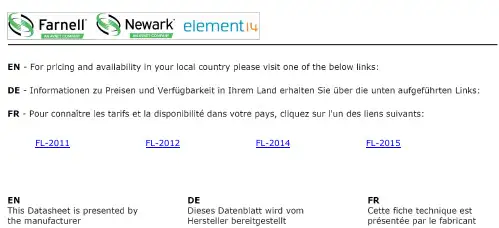
FL-2011FL-2012FL-2014FL-2015The FL-2000 Series offers a wide variety of precision flowmeters for use in medical, industrial, chemical, and laboratory applications at an economical price. Units are available with or without valves.Acrylic FlowmetersB-15aFL-2000 SeriesSpeciFicationSaccuracy:Models FL-2001–FL-2025: ±5% F.S. Models FL-2031–FL-2069: ±3% F.S. Models FL-2071–FL-2128: ±2% F.S.Float: Black glass stainless steel Body: Clear acrylicSeals: Buna “O” Rings with brass or PVC fittings FKM “O”-Rings with stainless steel fittingspressure: 100 psig max @ 21°C (70°F)temperature:65°C (150°F) max @ 0 psigFittings: Brass std; stainless steel optional except for FL-2071 through FL-2128, which have 1 NPT PVC fittings onlyValves: Models FL-2001 throughFL-2069: brass standard; stainless steel cartridge type (optional)FL-2071 through FL-2128: Optional plastic in-line gateU e asy-to-Read english or Metric Scales U W ater Ranges from 4 ccM to 20 GpM, air Ranges from 40 ccM to 4000 LpM U t hreaded Brass inserts for Quick installation U e asy Disassembly and assembly for Maintenance U D urable one-piece clear acrylic construction U S table, easy-to-Read Float U S uperior Quality appLicationS U a ir Sampling equipment U a quaculture U D esalinization equipment U G as analyzers U M edical Systems U p hoto processing equipment U W ater treatment andDistribution SystemsFL-2013 air, shownsmaller than actual size.FL-2066-nV Water, shownsmaller than actual size.B(13.5)B-15bFL-2091 through FL-2128 DimensionsTo order with plastic integral gate valve, add suffix “-V” to model number for additional cost for FL-2090 Series, and FL-2120 Series.For optional 10-point NIST certificate add suffix, “-NIST” to the model number, for additional cost and two weeks to the standard lead time.Ordering Example: FL-2095, rotameter, 100 to 1400 LPM Air FL-2127-V, rotameter, 4 to 36 LPM water, with valves.FL-2097, shown smaller than actual sizeUnits are standard without valves.To order with plastic integral gate valve, add suffix “-V” to model number for additional cost.For optional 10-point NIST certificate add suffix, “-NIST” to the model number for additional cost and two weeks to the standard lead time.Ordering Examples: FL-2075, rotameter valve, 100 to 1400 LPM air.FL-2080, rotameter valve, 2 to 19 LPM water.FL-2041-nV, shown smaller than actual size.FL-2053, Water,shown smaller thanactual size.FL-2066-nV, shown smaller than actual size.To order with stainless steel valve, add suffix “-SS” to model number for additional cost.To order without a valve, add suffix “-NV” to model number and subtract from cost.For optional 10-point NIST certificate add suffix, “-NIST” to the model number, for additional cost and two weeks to the standard lead time.Ordering Examples: FL-2036, economical rotameter, with brass valve, 14 to 150 SCFH Air.FL-2036-NV , economical rotameter,without brass valve, 14 to 150 SCFH Air.BFL-2060, air, shown smaller than actual size.Dual scales supplied std: SCFM/SCFH, GPM/GPH and LPM/LPH To order with stainless steel valve, add suffix “-SS” to model number for additional cost.To order without a valve, add suffix “-NV” to model number and subtract from cost.For optional 10-point NIST certificate add suffix, “-NIST” to the model number, for additional cost and two weeks to the standard lead time.Ordering Examples: FL-2060, rotameter with brass valve, 0.5 to 5 SCFM. FL-2069-NV , rotameter no valve 2 to 20 LPM.FL-2091, air, shown smaller thanactual size.B-15cFL-2021-nV, Water, shown larger than actual size.Units come standard with brass valves and operator’s manual.To order with stainless steel valves, add suffix “-SS” to model number for additional cost.To order without a valve, add suffix “-NV” to model number and subtract from cost.For optional 10-point NIST certificate add suffix, “-NIST” to the model number, for additional cost and two weeks to the standard lead time.Ordering Examples: FL-2005, economical rotameter with brass valve, 2 to 20 SCFH air.FL-2005-NV , economical rotameter without valve, 2 to 20 SCFH air.accuracy: ±5% Full Scale panel MountB-15dFL-2011FL-2012FL-2014FL-2015。
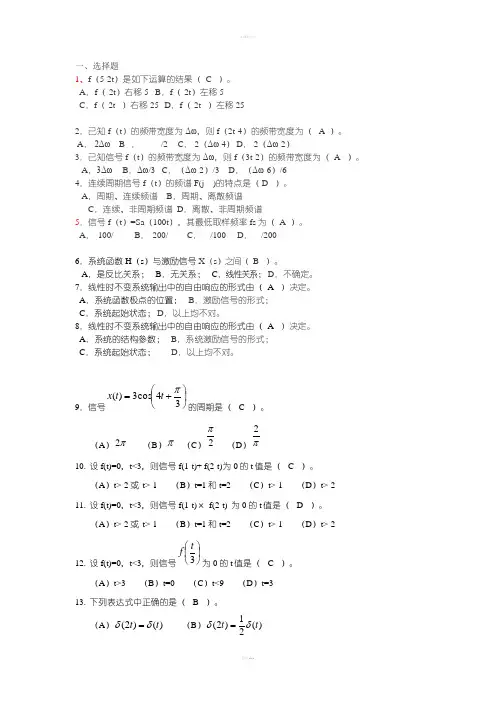
一、选择题1、f (5-2t )是如下运算的结果( C )。
A .f (-2t )右移5 B .f (-2t )左移5C .f (-2t )右移25D .f (-2t )左移252.已知f (t )的频带宽度为Δω,则f (2t-4)的频带宽度为( A )。
A . 2Δω B . /2 C . 2(Δω-4) D . 2(Δω-2)3.已知信号f (t )的频带宽度为Δω,则f (3t-2)的频带宽度为( A )。
A .3Δω B .Δω/3 C .(Δω-2)/3 D .(Δω-6)/6 4.连续周期信号f (t )的频谱F(j )的特点是( D )。
A .周期、连续频谱 B .周期、离散频谱 C .连续、非周期频谱 D .离散、非周期频谱5.信号f (t )=Sa (100t ),其最低取样频率fs 为( A )。
A . 100/ B . 200/ C ./100 D ./2006.系统函数H (s )与激励信号X (s )之间( B )。
A .是反比关系;B .无关系;C .线性关系;D .不确定。
7.线性时不变系统输出中的自由响应的形式由( A )决定。
A .系统函数极点的位置; B .激励信号的形式; C .系统起始状态; D .以上均不对。
8.线性时不变系统输出中的自由响应的形式由( A )决定。
A .系统的结构参数; B .系统激励信号的形式; C .系统起始状态; D .以上均不对。
9.信号⎪⎭⎫ ⎝⎛+=34cos 3)(πt t x 的周期是( C )。
(A )π2 (B )π (C )2π (D )π210. 设f(t)=0,t<3,则信号f(1-t)+ f(2-t)为0的t 值是( C )。
(A )t>-2或 t>-1 (B )t=1和t=2 (C )t>-1 (D )t>-2 11. 设f(t)=0,t<3,则信号f(1-t)× f(2-t) 为0的t 值是( D )。
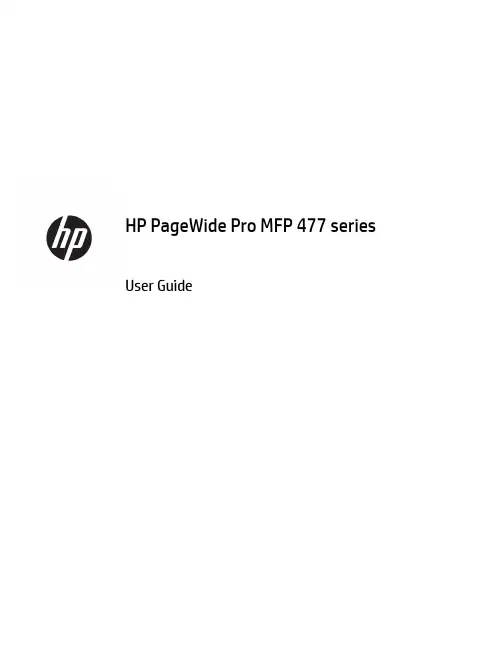
User GuideCopyright and License© 2016 Copyright HP Development Company, L.P.All rights reserved. Reproduction, adaptation, or translation of this material is prohibited without prior written permission of HP, except as allowed under copyright laws.The information contained in this document is subject to change without notice.The only warranties for HP products and services are set forth in the express warranty statements accompanying such products and services. Nothing herein should be construed as constituting an additional warranty. HP shall not be liable for technical or editorial errors or omissions contained herein.Edition 1, 2/2016Trademark CreditsAdobe®, Acrobat®, and PostScript® are trademarks of Adobe Systems Incorporated. Intel® Core™ is a trademark of Intel Corporation in the U.S. and other countries.Java™ is a US trademark of Sun Microsystems, Inc.Microsoft®, Windows®, Windows® XP, and Windows Vista® are U.S. registered trademarks of Microsoft Corporation.UNIX® is a registered trademark of The Open Group.ENERGY STAR and the ENERGY STAR mark are registered trademarks owned by the U.S. Environmental Protection Agency.Table of contents1 Product basics (1)Product features (2)Environmental features (3)Accessibility features (3)Product views (4)Front left view (4)Front right view (5)Back view (5)Cartridge door view (6)Power on and off (7)Turn the product on (7)Manage power (7)Turn the product off (8)Use the control panel (9)Control panel buttons (9)Control panel home screen (10)Control panel dashboard (11)Control panel application folders (11)Control panel shortcuts (12)Help features (12)Printer information (13)Help animations (13)Quiet Mode (14)To turn Quiet Mode on or off from the control panel (14)To turn Quiet Mode on or off from the EWS (14)2 Connect the product (15)Connect the product to a computer or a network (16)To connect the product using a USB cable (16)To connect the product to a network (17)Supported network protocols (17)Connect the product using a wired network (17)ENWW iiiConnect the product using a wireless network (wireless models only) (17)To connect the product to a wireless network using the Wireless SetupWizard (18)To connect the product to a wireless network using WPS (18)To connect the product to a wireless network manually (19)Use Wi-Fi Direct to connect a computer or device to the product (20)To turn on Wi-Fi Direct (20)To print from a wireless-capable mobile device (20)To print from a wireless-capable computer (Windows) (20)To print from a wireless-capable computer (OS X) (20)Install HP printer software for a wireless product already on the network (22)Open the printer software (Windows) (22)Manage network settings (22)View or change network settings (22)Set or change the product password (23)Manually configure TCP/IP parameters from the control panel (23)Link speed and duplex settings (23)3 Printer management and services (25)HP Embedded Web Server (26)About the EWS (26)About cookies (26)Open the EWS (27)Features (27)Home tab (27)Scan tab (28)Fax tab (29)Web Services tab (29)Network tab (29)Tools tab (29)Settings tab (30)Web Services (31)What are Web Services? (31)HP ePrint (31)Print apps (31)Set Up Web Services (31)Use Web Services (32)HP ePrint (32)Print apps (33)Remove Web Services (34)HP Web Jetadmin software (34)iv ENWWProduct security features (34)Security statements (35)Firewall (35)Security settings (36)Firmware updates (36)HP Printer Assistant in the printer software (Windows) (36)Open the HP Printer Assistant (36)Features (36)Connected tab (37)Print, Scan & Fax tab (37)Shop tab (37)Help tab (38)Tools tab (38)Estimated Levels tab (38)HP Utility (OS X) (38)AirPrint™ (OS X) (38)4 Paper and print media (39)Understand paper use (40)Supported media sizes (41)Supported paper and print media sizes (41)Supported envelope sizes (42)Supported card and label sizes (42)Supported photo media sizes (42)Supported paper types and tray capacity (43)Tray 1 (multipurpose) on left side of the product (43)Tray 2 (default tray) and Tray 3 (accessory tray) (44)Configure trays (44)Load media (45)Load Tray 1 (45)Load Tray 2 (46)Load optional Tray 3 (48)Load envelopes (49)Load letterhead or preprinted forms (51)Load the automatic document feeder (52)Load the scanner (53)Tips for selecting and using paper (55)5 Cartridges (56)HP PageWide cartridges (57)HP policy on non-HP cartridges (57)ENWW vManage cartridges (57)Store cartridges (58)Print with General Office mode (58)Print when a cartridge is at estimated end of life (58)Check the estimated cartridge levels (58)Order cartridges (59)Recycle cartridges (60)Replace cartridges (60)Tips for working with cartridges (62)6 Print (63)Print from a computer (64)To print from a computer (Windows) (64)To print from a computer (OS X) (65)To set up printing shortcuts (Windows) (66)To set up printing presets (OS X) (66)To adjust or manage colors (67)Choose a preset color theme for a print job (67)Adjust the color options for a print job manually (67)Match colors to your computer screen (68)Control access to color printing (69)Print from the control panel (69)Print using job storage (69)To enable job storage (69)Disable or enable job storage (Windows) (69)Disable or enable job storage (OS X) (69)To apply job storage to one or all print jobs (70)Apply job storage to one or all print jobs (Windows) (70)Apply job storage to one or all print jobs (OS X) (71)To print a job stored on the printer (71)To delete a job stored on the printer (71)Print from a USB device (72)Print with NFC (72)Print with HP ePrint (72)Print off site by sending an email with the HP ePrint app (32)Print from an on-site computer or mobile device (73)Print with AirPrint (OS X) (73)Tips for print success (74)Cartridge tips (74)Paper loading tips (74)vi ENWW7 Copy and scan (76)Copy (77)Copy settings (77)Adjust lightness or darkness for copies (77)Select a paper tray and paper size for copies (77)Reduce or enlarge a copy (77)Load and copy identification cards (78)Copy photos (79)Load and copy mixed-size originals (80)Copy on both sides automatically (80)Cancel a copy job (80)Scan (81)Scan to a USB drive (81)Scan to a computer (81)To set up scan to computer (81)Set up scanning to a computer (Windows) (82)Set up scanning to a computer (OS X) (82)To scan to a computer from the control panel (82)Scan to email (82)To set up scan to email (82)To scan a document or photo to email (83)Scan a document or photo to email from the control panel (83)Scan a document or photo to email from the printer software (83)To change account settings (83)Scan to a network folder (83)To set up scan to a network folder (84)Set up scan to a network folder in the EWS (84)Set up scan to a network folder in the HP Printer Assistant (84)To scan to a network folder (84)Scan to a network folder from the control panel (84)Scan to a network folder from the printer software (84)Scan to SharePoint (85)To set up scan to SharePoint (85)To scan to SharePoint (85)Scan using HP scanning software (85)Scan using other software (86)To scan from a TWAIN-compliant program (86)To scan from a WIA-compliant program (86)ENWW viiGuidelines for scanning documents as editable text (87)To scan a document to editable text (Windows) (88)To scan documents as editable text (OS X) (89)Tips for copy and scan success (90)8 Fax (91)Set up fax (92)Connect fax to a telephone line (92)Configure fax settings (92)To configure fax settings from the control panel (92)To configure fax settings using the HP Digital Fax Setup Wizard (Windows) (93)Set up HP Digital Fax (93)HP Digital Fax requirements (93)To set up HP Digital Fax (94)Set up HP Digital Fax (Windows) (94)Set up HP Digital Fax (OS X) (94)Set up HP Digital Fax in the EWS (94)To modify HP Digital Fax settings (94)Modify HP Digital Fax settings (Windows) (94)Modify HP Digital Fax settings (OS X) (94)Modify HP Digital Fax settings in the EWS (94)To turn off HP Digital Fax (95)Fax programs, systems, and software (95)Supported fax programs (95)Supported phone services - analog (95)Alternate phone services - digital (95)DSL (95)PBX (95)ISDN (96)VoIP (96)Set fax settings (96)Send-fax settings (96)Set pauses or flash hooks (96)Set a dialing prefix (97)Set tone-dialing or pulse-dialing (97)Set autoredial and the time between redials (97)Set the light/dark setting (98)Set the default resolution (98)Use cover-page templates (99)viii ENWWSet fax forwarding (99)Block or unblock fax numbers (100)Set the number of rings-to-answer (100)Set distinctive ring (101)Use autoreduction for incoming faxes (102)Set the fax sounds volume (102)Set stamp-received faxes (102)Send a fax (102)Send a fax from the control panel (103)Use speed dials and group-dial entries (103)Send a standard fax from the computer (103)Send a fax from the software (104)Send a fax using monitor dialing (105)Send a fax using printer memory (105)Receive a fax (106)Receive a fax manually (106)Fax memory (107)Reprint a fax (107)Delete faxes from memory (107)Use the phone book (107)Create and edit individual speed-dial entries (108)Create and edit group-dial entries (108)Delete speed-dial entries (108)Use reports (108)Print fax confirmation reports (109)Print fax error reports (110)Print and view the fax log (110)Clear the fax log (110)Print the details of the last fax transaction (111)Print a Caller ID Report (111)View the Call History (111)9 Solve problems (112)Problem-solving checklist (113)Check that the product power is on (113)Check the control panel for error messages (113)Test print functionality (113)Test copy functionality (114)Test the fax-sending functionality (114)Test the fax-receiving functionality (114)ENWW ixTry sending a print job from a computer (114)Test the plug-and-print USB functionality (114)Factors that affect product performance (114)Information pages (115)Factory-set defaults (116)Cleaning routines (116)Clean the printhead (117)Clean the scanner glass strip and platen (117)Clean the document feeder pick rollers and separation pad (118)Clean the touch screen (118)Jams and paper-feed issues (119)The product does not pick up paper (119)The product picks up multiple sheets of paper (119)Prevent paper jams (119)Clear jams (120)Jam locations (120)Clear jams from the document feeder (121)Clear jams in Tray 1 (multipurpose tray) (122)Clear jams in Tray 2 (122)Clear jams in optional Tray 3 (123)Clear jams in the left door (124)Clear jams in the output bin (125)Clear jams in the duplexer (126)Cartridge issues (127)Refilled or remanufactured cartridges (127)Interpret control panel messages for cartridges (127)Cartridge Depleted (127)Cartridge Low (128)Cartridge Very Low (128)Counterfeit or used [color] cartridge installed (128)Do not use SETUP cartridges (128)Genuine HP cartridge installed (128)Incompatible [color] (129)Incompatible cartridges (129)Install [color] cartridge (129)Non-HP cartridges installed (129)Printer Failure (130)Problem with Print System (130)Problem with Printer Preparation (130)Problem with SETUP cartridges (130)Use SETUP cartridges (130)x ENWWUsed [color] installed (131)Printing issues (131)The product does not print (131)The product prints slowly (132)Plug-and-print USB issues (132)The Memory Device Options menu does not open when you insert the USBaccessory (132)The file does not print from the USB storage device (132)The file that you want to print is not listed in the Memory Device Options menu (133)Improve print quality (133)Check for genuine HP cartridges (133)Use paper that meets HP specifications (133)Use the correct paper type setting in the printer driver (134)Change the paper type and size setting (Windows) (134)Change the paper type and size setting (OS X) (134)Use the printer driver that best meets your printing needs (134)Align the printhead (135)Print a print-quality report (135)Scan issues (135)Fax issues (136)Fax troubleshooting checklist (136)Change error correction and fax speed (137)Set the fax-error-correction mode (137)Change the fax speed (137)Fax logs and reports (137)Print individual fax reports (137)Set the fax error report (138)Fax error messages (138)Communication error. (138)Document feeder door is open. Canceled fax. (139)Fax is busy. Canceled send. (139)Fax is busy. Redial pending. (139)Fax receive error. (140)Fax Send error. (140)Fax storage is full. Canceling the fax receive. (141)Fax storage is full. Canceling the fax send. (141)No dial tone. (141)No fax answer. Canceled send. (142)No fax answer. Redial pending. (142)No fax detected. (142)Solve problems sending faxes (143)ENWW xiAn error message displays on the control panel (143)Document feeder paper jam (143)Scanner error (143)The control panel displays a Ready message with no attempt to send the fax. (143)The control panel displays the message "Receiving Page 1" and does not progressbeyond that message (144)Faxes can be received, but not sent (144)Unable to use fax functions from the control panel (144)Unable to use speed dials (144)Unable to use group dials (144)Receive a recorded error message from the phone company when trying to senda fax (145)Unable to send a fax when a phone is connected to the product (145)Solve problems receiving faxes (145)An error message displays on the control panel (145)The fax does not respond (145)Voice mail is available on the fax line (145)The product is connected to a DSL phone service (146)The product uses a fax over IP or VoIP phone service (146)Sender receives a busy signal (146)A handset is connected to the product (146)A phone line splitter is being used (146)Cannot send or receive a fax on a PBX line (146)Solve general fax problems (146)Faxes are sending slowly (146)Fax quality is poor (147)Fax cuts off or prints on two pages (147)Connectivity issues (147)Solve USB direct-connect problems (147)Solve network problems (148)Poor physical connection (148)The computer is using the incorrect IP address for the product (148)The computer is unable to communicate with the product (148)The product is using incorrect link and duplex settings for the network (149)New software programs might be causing compatibility problems (149)The computer or workstation might be set up incorrectly (149)The product is disabled, or other network settings are incorrect (149)Wireless network issues (149)Wireless connectivity checklist (149)The product does not print, and the computer has a third-party firewall installed (150)The wireless connection does not work after moving the wireless router or product (150)xii ENWWCannot connect more computers to the wireless product (150)The wireless product loses communication when connected to a VPN (151)The network does not appear in the wireless networks list (151)The wireless network is not functioning (151)Product software issues (Windows) (151)Product software issues (OS X) (153)The printer driver is not listed in the Print & Scan list (153)The product name does not appear in the product list in the Print & Scan list (153)The printer driver does not automatically set up the selected product in the Print & Scan list (153)A print job was not sent to the product that you wanted (153)When connected with a USB cable, the product does not appear in the Print & Scan list afterthe driver is selected. (153)You are using a generic printer driver when using a USB connection (154)10 Service and support (155)Customer support (156)HP limited warranty statement (157)UK, Ireland, and Malta (158)Austria, Belgium, Germany, and Luxemburg (158)Belgium, France, and Luxemburg (159)Italy (160)Spain (160)Denmark (161)Norway (161)Sweden (161)Portugal (162)Greece and Cyprus (162)Hungary (162)Czech Republic (163)Slovakia (163)Poland (163)Bulgaria (164)Romania (164)Belgium and the Netherlands (164)Finland (165)Slovenia (165)Croatia (165)Latvia (165)Lithuania (166)Estonia (166)Russia (166)ENWW xiiiAppendix A Technical information (167)Product specifications (168)Print specifications (168)Physical specifications (168)Power consumption and electrical specifications (168)Acoustic emission specifications (168)Environmental specifications (168)Environmental product stewardship program (170)Protecting the environment (171)Ozone production (171)Power consumption (171)European Union Commission Regulation 1275/2008 (171)Paper (171)HP PageWide printing supplies (171)Plastics (171)Electronic hardware recycling (172)Material restrictions (172)General battery information (172)Battery disposal in Taiwan (172)California Perchlorate Material Notice (172)EU Battery Directive (172)Battery notice for Brazil (173)Chemical substances (173)EPEAT (173)Disposal of waste equipment by users (173)Toxic and hazardous substance table (China) (174)Restriction on hazardous substances statement (Turkey) (174)Restriction on hazardous substances statement (Ukraine) (174)Restriction of hazardous substance statement (India) (174)China energy label for printer, fax, and copier (175)China SEPA Eco Label user information (175)Regulatory information (176)Regulatory notices (176)Regulatory model identification number (176)FCC statement (176)VCCI statement (Japan) (177)Power cord instructions (177)Power cord statement (Japan) (177)EMC statement (Korea) (177)Visual display workplaces statement for Germany (177)European Union Regulatory Notice (178)xiv ENWWEuropean Union Regulatory Notice (178)Wireless models only (178)Models with fax capability only (178)Additional statements for telecom (fax) products (179)New Zealand telecom statements (179)Additional FCC statement for telecom products (US) (179)Industry Canada CS-03 requirements (180)Notice to users of the Canadian telephone network (181)Australia wired fax statement (181)Notice to users of the German telephone network (181)Additional statements for wireless products (182)Exposure to radio frequency radiation (182)Notice to users in Brazil (182)Canadian statements (182)Japan statement (183)Notice to users in Korea (183)Taiwan statement (183)Mexico statement (183)Index (184)ENWW xvxvi ENWW1Product basics●Product features●Product views●Power on and off●Use the control panel●Quiet ModeENWW1Product featuresPageWide Pro MFP 477dnD3Q19A, D3Q19B, D3Q19C,D3Q19D Tray capacity (75 GSM or 20–lb Bond paper)●Tray 1: 50 sheets ●Tray 2: 500 sheets ●Optional Tray 3: 500 sheets ●Automatic Document Feeder(ADF): 50 sheets●Standard output bin: 300sheetsPrint ●Simplex speeds up to 40 pagesper minute (ppm) for both color and black with Professional quality●Duplex speeds up to 21 ppmfor both color and black with Professional quality●Up to 55 ppm in General Officemode●Walkup Plug-and-Print USBDevice port●Walkup printing of MS Officedocuments Copy ●Simplex speeds up to 40 ppm in black and color ●Single-pass, two-sided copying for speeds up to 26 ppm in black and color ●50-sheet ADF supports page sizes up to 356 mm (14.0 in) in length and 216 mm (8.5 in) in width Scan●Duplex speeds up to 26 ppm for both color and black ●Scan to walkup USB device, email address, network folder, or SharePoint site ●Glass supports page sizes up to 356 mm (14.0 in) in length and up to 216 mm (8.5 in) in width ●HP software enables scanning a document to a file that can be edited ●Compatible with TWAIN, WIA, and WS-Scan programs Fax●Fax to email address ornetwork folder●Fax from walkup control panelor from program on connected computer●Fax archive, fax log, junk-faxblocking, non-volatile fax memory, fax redirect featureConnectivity ●802.3 LAN (10/100) Ethernet port ●Host USB Type A and Type B ports (back)●USB 2.0 Device port (front)PageWide Pro MFP 477dw D3Q20A, D3Q20B, D3Q20C, D3Q20D Has the same features as the PageWide Pro MFP 477dn, and includes the following:●Embedded wireless capability ●802.11n 5GHz dual bandsupport●HP ePrint—send documents tothe product email address for printing●HP Wireless Direct support ●NFC-enabled (Near FieldCommunications); walkup printing from smart phones and tablets●Scan to smart phone 2Chapter 1 Product basics ENWWEnvironmental featuresFeature Environmental benefitDuplex printing Automatic duplex printing is available on all models of HP PageWide Pro MFP477dn/dw series. Duplex printing saves the environment and saves you money.Print multiple pages per sheet Save paper by printing two or more pages of a document side-by-side on onesheet of paper. Access this feature through the printer driver.Copies multiple pages per sheet Save paper by copying two pages of an original document side-by-side on onesheet of paper.Recycling Reduce waste by using recycled paper.Recycle cartridges by using the HP Planet Partners return process.Energy savings Sleep modes and timer options enable this product to quickly go into reducedpower states when not printing, thus saving energy. Accessibility featuresThe product includes several features that aid users with limited vision, hearing, dexterity or strength.●Online user guide that is compatible with text screen-readers.●Cartridges can be installed and removed using one hand.●All doors and covers can be opened using one hand.ENWW Product features3Product views●Front left view●Front right view●Back view●Cartridge door viewFront left viewLabel Description1USB device connection port2Cartridge door3Tray 1 extension4Tray 15Power button6Tray 2–main paper tray7Control panel8Scanner glass4Chapter 1 Product basics ENWWFront right viewLabel Description1Automatic document feeder (ADF) cover2Main output door3ADF paper guides4ADF loading area5ADF output bin6ADF output bin stop7Main output bin stop8Main output binBack viewLabel Description1Ethernet connection port2Fax connection ports3USB Type A and USB Type B ports4Power cord connectionENWW Product views5Label Description5Left door6DuplexerCartridge door viewLabel Description1Cartridge slots2Product serial number and product number3Cartridge part numbers6Chapter 1 Product basics ENWWPower on and offNOTICE:To prevent damage to the product, use only the power cord that is provided with the product.●Turn the product on●Manage power●Turn the product offTurn the product on1.Connect the power cord that is provided with the product to the connection port on the back of theproduct.2.Connect the power cord to a wall outlet with an adequate voltage rating.NOTE:Make sure that your power source is adequate for the product voltage rating. The product useseither 100-240 Vac or 200-240 Vac and 50/60 Hz.3.Press and release the power button on the front of the product.Manage powerHP PageWide Pro MFP 477dn/dw series printers include power-management features that can help reducepower consumption and save energy.●Sleep Mode puts the product in a reduced power-consumption state if it has been idle for a specificlength of time. You can set the length of time before the product enters Sleep Mode from the controlpanel.●Schedule On/Off enables you to turn the product on or off automatically at days and time that you setfrom the control panel. For example, you can set the product to turn off at 6 p.m. on Monday throughFriday.Set the Sleep Mode time1.Open the control panel dashboard (swipe the dashboard tab at the top of any screen downward, ortouch the dashboard area on the home screen).2.On the control panel dashboard, touch .ENWW Power on and off73.Touch Power Management, and then touch Sleep Mode.4.Select one of the time-interval options.The product switches into a reduced power-consumption state when it has been idle for the amount of timethat you select.Schedule the product to turn on or off1.Open the control panel dashboard (swipe the dashboard tab at the top of any screen downward, ortouch the dashboard area on the home screen).2.On the control panel dashboard, touch .3.Touch Power Management, and then touch Schedule Printer On/Off.4.Turn the Schedule On or Schedule Off option on.5.Select the Schedule On or Schedule Off options at the bottom of the screen, and then select the day andtime that you want to schedule.The product switches on or off at the time you select on the day you select.NOTE:The product cannot receive faxes when it is turned off. Faxes sent during a scheduled off interval willprint when the product is turned on.Turn the product offNOTICE:Do not turn off the product if a cartridge is missing. Damage to the product can result.▲Press and release the power button on the front of the product to turn off your HP PageWide Pro MFP 477dn/dw series printer.A warning message appears on the control panel if you attempt to turn the product off when one ormore cartridges are missing.NOTICE:To prevent print-quality problems, turn off the product by using the power button on the frontonly. Do not unplug the product, turn off the powerstrip, or use any other method.8Chapter 1 Product basics ENWWUse the control panel●Control panel buttons●Control panel home screen●Control panel dashboard●Control panel application folders●Control panel shortcuts●Help featuresNOTE:The small text on the control panel is not designed for prolonged viewing.Control panel buttonsButtons and indicator lights on the control panel of HP PageWide Pro MFP 477dn/dw series printers appear litwhen their function is available, and are darkened if their function is not available.1Home button.Touch to view the control panel home screen.2Wireless network indicator.Solid blue when the product is connected to a wireless network. Blinks when the product is searching for awireless connection. Off when the product is connected to a wired network or by a USB cable.3NFC (Near Field Communications) indicator.The product can be enabled for walkup printing from tablets and smart phones.4Back or Cancel button.Touch to return to the previous screen, or to cancel the current process.5Help button.Touch to view the Help menu options.ENWW Use the control panel9。
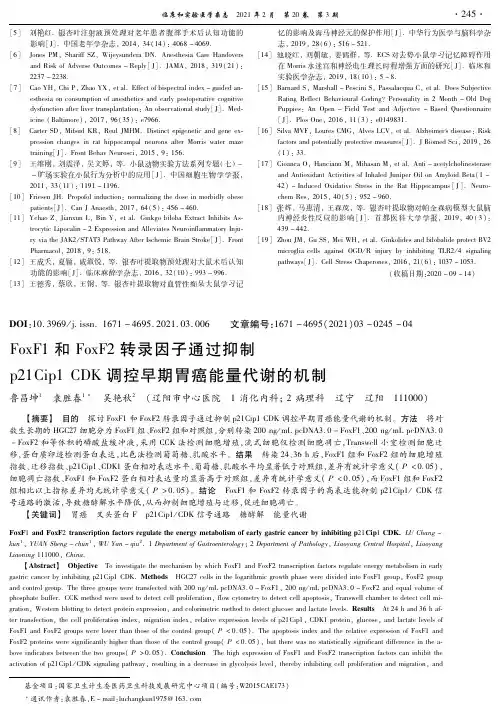
[5] 刘艳红.银杏叶注射液预处理对老年患者腹部手术后认知功能的影响[J].中国老年学杂志,2014,34(14):4068-4069.[6] JonesPM,ShariffSZ,WijeysunderaDN.AnesthesiaCareHandoversandRiskofAdverseOutcomes-Reply[J].JAMA,2018,319(21):2237-2238.[7] CaoYH,ChiP,ZhaoYX,etal.Effectofbispectralindex-guidedanesthesiaonconsumptionofanestheticsandearlypostoperativecognitivedysfunctionafterlivertransplantation:Anobservationalstudy[J].Med icine(Baltimore),2017,96(35):e7966.[8] CarterSD,MifsudKR,ReulJMHM.DistinctepigeneticandgeneexpressionchangesinrathippocampalneuronsafterMorriswatermazetraining[J].FrontBehavNeurosci,2015,9:156.[9] 王维刚,刘震泽,吴文婷,等.小鼠动物实验方法系列专题(七)--旷场实验在小鼠行为分析中的应用[J].中国细胞生物学学报,2011,33(11):1191-1196.[10]FriesenJH.Propofolinduction:normalizingthedoseinmorbidlyobesepatients[J].CanJAnaesth,2017,64(5):456-460.[11]YehaoZ,JianxunL,BinY,etal.GinkgobilobaExtractInhibitsAstrocyticLipocalin-2ExpressionandAlleviatesNeuroinflammatoryInju ryviatheJAK2/STAT3PathwayAfterIschemicBrainStroke[J].FrontPharmacol,2018,9:518.[12]王成夭,夏颖,咸淑悦,等.银杏叶提取物预处理对大鼠术后认知功能的影响[J].临床麻醉学杂志,2016,32(10):993-996.[13]王德秀,蔡欣,王钢,等.银杏叶提取物对血管性痴呆大鼠学习记忆的影响及海马神经元的保护作用[J].中华行为医学与脑科学杂志,2019,28(6):516-521.[14]池晓红,刘朝敏,姜鹤群,等.ECS对去势小鼠学习记忆障碍作用在Morris水迷宫和神经电生理长时程增强方面的研究[J].临床和实验医学杂志,2019,18(10):5-8.[15]BarnardS,Marshall-PesciniS,PassalacquaC,etal.DoesSubjectiveRatingReflectBehaviouralCoding?Personalityin2Month-OldDogPuppies:AnOpen-FieldTestandAdjective-BasedQuestionnaire[J].PlosOne,2016,11(3):e0149831.[16]SilvaMVF,LouresCMG,AlvesLCV,etal.Alzheimer'sdisease:Riskfactorsandpotentiallyprotectivemeasures[J].JBiomedSci,2019,26(1):33.[17]CioancaO,HancianuM,MihasanM,etal.Anti-acetylcholinesteraseandAntioxidantActivitiesofInhaledJuniperOilonAmyloidBeta(1-42)-InducedOxidativeStressintheRatHippocampus[J].Neuro chemRes,2015,40(5):952-960.[18]张辉,马惠清,王森茂,等.银杏叶提取物对帕金森病模型大鼠脑内神经炎性反应的影响[J].首都医科大学学报,2019,40(3):439-442.[19]ZhouJM,GuSS,MeiWH,etal.GinkolidesandbilobalideprotectBV2microgliacellsagainstOGD/RinjurybyinhibitingTLR2/4signalingpathways[J].CellStressChaperones,2016,21(6):1037-1053.(收稿日期:2020-09-14) DOI:10.3969/j.issn.1671-4695.2021.03.006 文章编号:1671-4695(2021)03-0245-04FoxF1和FoxF2转录因子通过抑制p21Cip1CDK调控早期胃癌能量代谢的机制鲁昌坤1 袁胜春1 吴艳秋2 (辽阳市中心医院 1消化内科;2病理科 辽宁 辽阳 111000)基金项目:国家卫生计生委医药卫生科技发展研究中心项目(编号:W2015CAE173)通讯作者:袁胜春,E-mail:luchangkun1975@163.com 【摘要】 目的 探讨FoxF1和FoxF2转录因子通过抑制p21Cip1CDK调控早期胃癌能量代谢的机制。
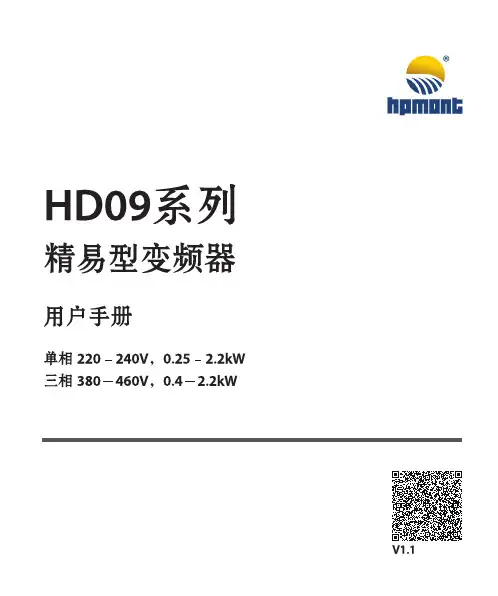
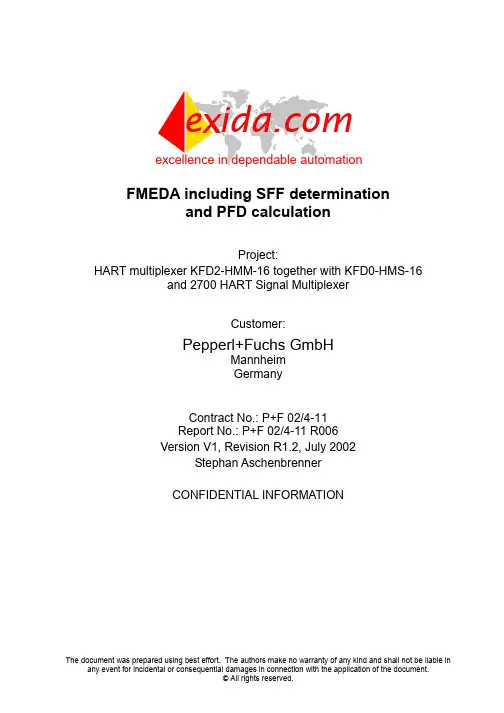
eexcellence in dependable automationFMEDA including SFF determinationand PFD calculationProject:HART multiplexer KFD2-HMM-16 together with KFD0-HMS-16 and 2700 HART Signal MultiplexerCustomer:Pepperl+Fuchs GmbHMannheimGermanyContract No.: P+F 02/4-11Report No.: P+F 02/4-11 R006Version V1, Revision R1.2, July 2002Stephan AschenbrennerCONFIDENTIAL INFORMATIONManagement summaryThis report summarizes the results of the analysis carried out on the HART multiplexerKFD2-HMM-16 together with KFD0-HMS-16 and the 2700 HART Signal Multiplexer.The assessment does not contain an evaluation of the correct functioning of the HARTmultiplexer but a statement about the interference freeness on the safety related 4..20mAloop when used for HART communication with regard to the suitability in part for Safety Instrumented System (SIS) usage in a particular Safety Integrity Level (SIL).The failure rates are based on the Siemens standard SN 29500.According to table 2 of IEC 61508-1 the average PFD for systems operating in low demandmode has to be ≥10-4 to < 10-3 for SIL 3 safety functions and ≥10-3 to < 10-2 for SIL 2 safetyfunctions. However, as the modules under consideration are only one part of an entire safetyfunction they should not claim more than 10% of this range, i.e. they should be better than orequal to 10-4 for SIL 3 and better than or equal to 10-3 for SIL 2.The modules under evaluation can be considered to be Type B components. However, the components that can contribute to a disturbance of the safety system are considered to be TypeA components.For Type A components the SFF has to fulfill the requirements as stated in table 2 ofIEC 61508-2 which are the following:Hardware fault tolerance (HFT)0 1 2 SIL 2 60% ≤ SFF < 90% SFF < 60%SIL 3 90% ≤ SFF < 99% 60% ≤ SFF < 90% SFF < 60%The following tables show under which conditions the critical components of the two modulesthat can contribute to a disturbance of the safety system fulfill this requirement (considering onlyone communication line being part of the safety function).Table 1: KFD2-HMM-16 together with KFD0-HMS-16 without additional module interfaceT[Proof] = 1 year T[Proof] = 5 years T[Proof] = 10 yearsPFD AVG = 1.23E-06PFD AVG = 6.13E-06PFD AVG = 1.23E-05than 10% of this range, i.e. to be better than or equal to 10-3. The PFD values even fulfill the requirements of higher SILs but the system does only fulfill the architectural constraints requirements (HFT/SFF) for SIL 2 which are set by table 2 of IEC 61508-2 for type A components having a hardware fault tolerance of 0.If the HART multiplexer KFD2-HMM-16 and KFD0-HMS-16 are used together with the module interface as described in section 4.1 then two de-coupling capacitors have to fail to bring the (sub)system into a dangerous state. This corresponds to a hardware fault tolerance of 1.Table 2: KFD2-HMM-16 together with KFD0-HMS-16 with additional module interface T[Proof] = 1 year T[Proof] = 5 years T[Proof] = 10 yearsPFD AVG = 6.13E-08PFD AVG = 3.07E-07PFD AVG = 6.13E-07than 10% of this range, i.e. to be better than or equal to 10-4. The PFD values even fulfill the requirements of a higher SIL but the system does only fulfill the architectural constraints requirements (HFT/SFF) for SIL 3 which are set by table 2 of IEC 61508-2 for type A components having a hardware fault tolerance of 1.Table 3: 2700 HART Signal MultiplexerT[Proof] = 1 year T[Proof] = 5 years T[Proof] = 10 yearsPFD AVG = 2.50E-07PFD AVG = 1.25E-06PFD AVG = 2.50E-06than 10% of this range, i.e. to be better than or equal to 10-4. The PFD values even fulfill the requirements of higher SILs but the system does only fulfill the architectural constraints requirements (HFT/SFF) for SIL 3 which are set by table 2 of IEC 61508-2 for type A components having a hardware fault tolerance of 1.The calculations are based on the assumption that the HART multiplexer are mounted in an environment that is IP 54 compliant (e.g. housing, control cabinet or control room).Table of ContentsManagement summary (2)1Purpose and Scope (5)2Project management (5)2.1Roles of the parties involved (5)2.2Standards / Literature used (5)2.3Reference documents (6)2.3.1Documentation provided by the customer (6)2.3.2Documentation generated by (6)3Description of the HART communication (7)4Description of the analyzed modules (8)4.1KFD2-HMM-16 and KFD0-HMS-16 (8)4.22700 HART Signal Multiplexer (11)5Failure Modes, Effects, and Diagnostics Analysis (12)5.1Description of the failure categories (12)5.2Methodology – FMEDA, Failure rates (12)5.2.1FMEDA (12)5.2.2Failure rates (12)5.2.3Assumption (13)6Results of the assessment (13)6.1KFD2-HMM-16 and KFD0-HMS-16 (15)6.22700 HART Signal Multiplexer (17)7Terms and Definitions (19)8Status of the document (20)8.1Liability (20)8.2Releases (20)8.3Release Signatures (20)1 Purpose and ScopeThis report shall describe the results of the FMEDAs carried out on the HART multiplexer KFD2-HMM-16 together with KFD0-HMS-16 and the 2700 HART Signal Multiplexer.It shall be shown that the HART multiplexer do not electrically interfere with the connected safety related system when using the 4..20mA loop for the HART communication.It shall be assessed whether these modules meet the Probability of Failure on Demand (PFD) requirements for SIL 2 / SIL 3 sub-systems according to IEC 61508 with regard to the interference freeness on the safety related 4..20mA loop.The assessment does neither consider any calculations necessary for proving intrinsic safety nor an evaluation of the correct functioning of the HART multiplexer.Pepperl+Fuchs GmbH contracted in May 2002 with the FMEDA and PFD calculation of the above mentioned modules.2 Project management2.1 Roles of the parties involvedPepperl+Fuchs Manufacturer of the HART multiplexer. Did the FMEDAs together with the determination of the Safe Failure Fraction (SFF) and calculated the Probability of Failure on Demand (PFD)using Markov models.2.2 Standards / Literature usedThe services delivered by were performed based on the following standards / literature.[N1] IEC 61508-2:1999 Functional Safety of Electrical/Electronic/ProgrammableElectronic Safety-Related Systems[N2] ISBN: 0471133019 Electronic Components: Selection and Application Guidelinesby Victor MeeldijkJohn Wiley & Sons[N3] FMD-91, RAC 1991 Failure Mode / Mechanism Distributions[N4] SN 29500 Failure rates of components2.3 Reference documents2.3.1 Documentation provided by the customer[D1] DL0799, DL0800 of 21.04.01 Circuit diagram for KFD2-HMM-16 and KFD0-HMS-16 [D2] 107905 Bill of material for KFD2-HMM-16[D3] ES-984240/1-A1 of 18.11.99 Circuit diagram for 2700 HART Signal Multiplexer(Mother Board Multiplexer / Interface Circuit)[D4] CL-984240/1-A4 of 24.03.99 Bill of material for 2700 HART Signal Multiplexer (MotherBoard)[D5] ES-984240/2-A1 of 18.11.99 Circuit diagram for 2700 HART Signal Multiplexer(µProcessor Board)[D6] CL-984240/2-A3 of 16.03.99 Bill of material for 2700 HART Signal Multiplexer(µProcessor Board)[D7] Datasheet metallized polyester capacitor WIMA MKS 2 2.3.2 Documentation generated by [R1] FMEDA KFD2-HMM-16 V1 R1.0 – Analysis of 24.06.02[R2] FMEDA KFD2-HMM-16 V1 R1.0 – Results of 24.06.02[R3] FMEDA MUX 2700 V1 R1.0 – Analysis of 24.06.02[R4] FMEDA MUX 2700 V1 R1.0 – Results of 24.06.023 Description of the HART communicationThe HART1 protocol is supported by many conventional 4..20 mA field devices, which thus enable digital communication for configuration and servicing purposes. Many device parameters and also the measured values themselves can thus be digitally transferred to and from the device. This digital communication runs in parallel with the 4..20 mA signal on the same cable. This is possible through a current modulation, which is superimposed on the user signal.Figure 1: Modulated HART signalHART is a master-slave protocol: A field device does only respond when requested (except in "Burst mode").The message duration is several hundred milliseconds, so that between two and three messages can be transferred per second.On HART, there are three groups of commands:• The "Universal" commands; these must be supported by all field devices;• The "Common practice" commands; these are pre-defined commands, suitable for many field devices, which, if they are supported by the device, must be implemented in the pre-defined form;• Device-specific commands; these are commands, which are particularly suitable for this field device.1 HART = Highway Addressable Remote Transducer4 Description of the analyzed modulesIn safety-related applications the HART communication is used to provide additional (non safety-related) information about statuses and reading, allow for better preventive maintenance and thus improve the integrity of the field instrumentation.For this purpose the HART multiplexer have to be directly connected to the field wiring of the respective safety-related system (see Figure 2).Figure 2: Connection of the HART multiplexer with the safety-related system4.1 KFD2-HMM-16 and KFD0-HMS-16The HART multiplexer KFD2-HMM-16 can operate up to 256 analog transmitters. The built-in slave unit operates the first 16 loops, and a maximum of further 15 KFD0-HMS-16 slaves can be connected.The power supply (24 VDC nominal voltage) is provided via the power rail or terminals 17 and 18. The optional slave units or the RPI control module are connected with the master via a 14-core flat cable. Its connector is placed on the same housing side as the terminals for the RS 485 interface and the voltage supply.The analog signals for each unit are connected separately via a 26-core cable. 16 leads are provided for the HART signals of the analog instrument circuits, the other 10 are connected to ground.The minimum load resistance of the analog instrument circuits is 230 Ω (min. load resistance in accordance with the HART specification), the max. load resistance is 500 Ω. Load resistances of up to 1000 Ω are possible, however, resistance values greater than 500 Ω can interfere with the HART communication.A process control system or a PC can be connected via a RS 485 interface (terminals 13, 14 and 15). Up to 31 KFD2-HMM-16 can be operated on one RS 485 interface. Terminals 19, 20 and 21 can be used to connect additional stations to the RS 485 interface. The DIP-switch on the housing front is for the setting of the RS 485 address and the baud rate.Figure 3: Block diagram of KFD2-HMM-1626 pin connectorfor up to16 analog signal sources 14 pin connector for up to 15 KFD0-HMS-16 devicesFigure 4: Block diagram of KFD2-HMS-16The HART multiplexer KFD2-HMM-16 (KFD0-HMS-16) has only one de-coupling capacitor for each analog signal as can be seen in Figure 3 and Figure 4, but can be connected to a module interface as shown in Figure 5 to also have the ground de-coupled by a second capacitor. Figure 5: Block diagram HART multiplexer with module interface for loop 1 and 24.2 2700 HART Signal MultiplexerThe Mux2700 HART Multiplexer provides 32 signal channels for connection to “smart” transmitters or control devices supporting digital communication according to the HART standard.Two Decoupling Capacitors are provided, one for each signal connection.Both + Ve (positive) & - Ve (negative) signal wires are therefore decoupled from DC signal. Only the high frequency digital HART protocol signal passes through to the internal Multiplexer circuitry.It acts as a gateway between a workstation - typically a PC - and the field instrumentation.Each Mux2700 is networked simply by connecting the high-speed RS485 output in multidrop configuration. The Mux2700 interrogates each field device, under the supervision of the workstation, retrieving information for storage in its internal database, which can then be accessed at ease.Figure 6: Block diagram of 2700 HART Signal Multiplexer5 Failure Modes, Effects, and Diagnostics Analysis5.1 Description of the failure categoriesThe fail-safe state is defined as the HART multiplexer is not communicating.Failures are categorized and defined as follows:A safe failure (S) is defined as a single failure that causes the HART multiplexer not to communicate.A dangerous failure (D) is defined as a single failure that disturbs the safety system connected to the HART multiplexer.A “don't care” failure (#) is defined as a single failure of a component that is part of the safety function but has no effect on the safety function of the module / (sub)system.5.2 Methodology – FMEDA, Failure rates5.2.1 FMEDAA Failure Modes and Effects Analysis (FMEA) is a systematic way to identify and evaluate the effects of different component failure modes, to determine what could eliminate or reduce the change of failure, and to document the system in consideration.An FMEDA (Failure Mode Effect and Diagnostic Analysis) is an FMEA extension. It combines standard FMEA techniques with extension to identify online diagnostics techniques and the failure modes relevant to safety instrumented system design. It is a technique recommended to generate failure rates for each important category (safe detected, safe undetected, dangerous detected, dangerous undetected, fail high, fail low) in the safety models. The format for the FMEDA is an extension of the standard from MIL STD 1629A, Failure Modes and Effects Analysis.5.2.2 Failure ratesThe failure rate data used by in this FMEDA are from the Siemens SN 29500 failure rate database. The rates were chosen in a way that is appropriate for safety integrity level verification calculations. It is expected that actual field failure results with average environmental stress will be superior to the results predicted by these numbers.The user of these numbers is responsible for determining their applicability to any particular environment. Accurate plant specific data is preferable to general industry average data. Industrial plant sites with high levels of stress must use failure rate data that is adjusted to a higher value to account for the specific conditions of the plant.5.2.3 AssumptionThe following assumptions have been made during the Failure Modes, Effects, and Diagnostic Analysis of the HART multiplexer.• Failure rates are constant, wear out mechanisms are not included.• Propagation of failures is not relevant.• All component failure modes are known.• The repair time after a safe failure is 8 hours.• The average temperature over a long period of time is 40°C.• The stress levels are average for an industrial environment.• All modules are operated in the low demand mode of operation.• Only one communication line is considered to be part of the safety function.6 Results of the assessment did the FMEDAs supported by Pepperl+Fuchs.The analysis has shown that only a couple of components of the HART multiplexer can be found where potentially dangerous failure exist. All other component failures can only lead to the defined safe state but can never disturb the connected safety-related system. The following critical points were identified:1. Short circuits (to ground, to power or between each other) of the signal lines from theinterconnection terminal to the field side of the de-coupling capacitors;2. Short circuit of the de-coupling capacitor.For the calculation of the Safe Failure Fraction (SFF) the following has to be noted:λtotal consists of the sum of all component failure rates. This means:λtotal = λsafe + λdangerous + λdon’t care2SFF = 1 – λdu / λtotalFor the FMEDAs the following failure modes and below mentioned distributions were used. Capacitor fixed plastic (in accordance with [N3])Failure Mode Distribution (in %)Short 40 Open 42 Change in value 182 These are all failures that have no impact on the safety function. The behavior of the system is neither dangerous nor safe.Capacitor Al-ELKO (in accordance with [N3]) Failure ModeDistribution (in %)Short 38 Open 31 Seal failure31For the calculation of the PFD the following Markov models for a 1oo1 and 1oo2 architecture were used. As there are no explicit on-line diagnostics, no state “dd” – dangerous detected is required. As after a complete proof all states are going back to the OK state no proof rate is shown in the Markov models but included in the calculation.The proof time was changed using the Microsoft® Excel 2000 based FMEDA tool of as a simulation tool. The results are documented in the following sections.Figure 7: Markov model for a 1oo1 architectureAbbreviations: d The system has failed dangerous s The system has failed safe λd Failure rate of dangerous failures λs Failure rate of safe failures βCommon cause factor (set to 5%)T Repair Repair time τRepair Repair rate (1 / T Repair )Figure 8: Markov model for a 1oo2 architecture6.1 KFD2-HMM-16 and KFD0-HMS-16Item 1. of the critical points identified in section 6 can be excluded according to draft IEC 60947-5-3 A.1.2 if:• The HART multiplexer are mounted in a housing of minimum IP 54• The base material used is according to IEC 60249, the design and use of the printed board is according to IEC 60326 T3 and the creepage distances and clearances are designed according to IEC 60664-1 (1992) with pollution degree 2 / installation category III, or• The printed side(s) are coated with an insulation material in accordance to IEC 60664-3 (1992)Clearances and creepage distances according to IEC 60661-1 with pollution degree 2 / installation category II for a nominal voltage of 24 VDC are given in Table 4.Table 4: Clearances and creepage distances according to IEC 60661-1Clearances (table 2) Creepage distances (table 4) Printed wiring material 0,1 mm 0,04 mmAccording to Pepperl+Fuchs the base material used is according to IEC 60249 and the minimum creepage distances and clearances are 0,15 mm. This is considered to be sufficient as the interesting distances are part of an energy-consuming equipment supplied from fixed installation, i.e. installation category II. In addition the HART multiplexer is not a safety critical system itself but is connected to one. Thus there are no to special requirements with regard to reliability and availability (see section 2.2.2.1.1 of IEC 60664-1) and installation category III does not apply.Item 2. of the critical points identified in section 6 was analyzed in form of a FMEDA under the assumptions described in section 5.2.3 and 6.The following failure rates and SFF were calculated for the de-coupling capacitor:λtotal = 7,00E-10 1/hλsafe = 2,94E-10 1/hλdangerous = 2,80E-10 1/hλdon’t care = 1,26E-10 1/hSFF = 60,00% (HFT = 0)NOTE: As all faults of the additional electronic will either contribute to λsafe or λdon’t care with regard to the interference freeness on the 4..20mA signal the failure modes of the different components were not explicitly analyzed and are not part of the above mentioned failure rates.The PFD was calculated for three different proof times using the Markov model as described in Figure 7.T[Proof] = 1 year T[Proof] = 5 years T[Proof] = 10 yearsPFD AVG = 1.23E-06PFD AVG = 6.13E-06PFD AVG = 1.23E-05than 10% of this range, i.e. to be better than or equal to 10-3. The PFD values even fulfill the requirements of higher SILs but the system does only fulfill the architectural constraints requirements (HFT/SFF) for SIL 2 which are set by table 2 of IEC 61508-2 for type A components having a hardware fault tolerance of 0.The following figure shows the result of the PFD calculation for T[Proof] = 1 year.Figure 9: PFD for T[Proof] = 1 yearIf the HART multiplexer KFD2-HMM-16 and KFD0-HMS-16 are used together with the module interface as described in section 4.1 then two de-coupling capacitors have to fail to bring the (sub)system into a dangerous state. This corresponds to a hardware fault tolerance of 1.The PFD was calculated for three different proof times using the Markov model as described in Figure 8.T[Proof] = 1 year T[Proof] = 5 years T[Proof] = 10 yearsPFD AVG = 6.13E-08PFD AVG = 3.07E-07PFD AVG = 6.13E-07than 10% of this range, i.e. to be better than or equal to 10-4. The PFD values even fulfill the requirements of a higher SIL but the system does only fulfill the architectural constraints requirements (HFT/SFF) for SIL 3 which are set by table 2 of IEC 61508-2 for type A components having a hardware fault tolerance of 1.The following figure shows the result of the PFD calculation for T[Proof] = 1 year and β = 5% (maximum common cause factor for a logic sub-system according to IEC 61508-6).Figure 10: PFD for T[Proof] = 1 year and β = 5%6.2 2700 HART Signal MultiplexerItem 1. of the critical points identified in section 6 can be excluded according to draft IEC 60947-5-3 A.1.2 if:• The HART multiplexer are mounted in a housing of minimum IP 54• The base material used is according to IEC 60249, the design and use of the printed board is according to IEC 60326 T3 and the creepage distances and clearances are designed according to IEC 60664-1 (1992) with pollution degree 2 / installation category III, or• The printed side(s) are coated with an insulation material in accordance to IEC 60664-3 (1992)Clearances and creepage distances according to IEC 60661-1 with pollution degree 2 / installation category II for a nominal voltage of 24 VDC are given in Table 5.Table 5: Clearances and creepage distances according to IEC 60661-1Clearances (table 2) Creepage distances (table 4) Printed wiring material 0,1 mm 0,04 mmAccording to Pepperl+Fuchs the base material used is according to IEC 60249 and the minimum creepage distances and clearances are 0,25 mm. This is considered to be sufficient as the interesting distances are part of an energy-consuming equipment supplied from fixed installation, i.e. installation category II. In addition the HART multiplexer is not a safety critical system itself but is connected to one. Thus there are no to special requirements with regard to reliability and availability (see section 2.2.2.1.1 of IEC 60664-1) and installation category III does not apply.Item 2. of the critical points identified in section 6 was analyzed in form of a FMEDA under the assumptions described in section 5.2.3 and 6.The following failure rates and SFF were calculated for the two de-coupling capacitors: λtotal = 3,70E-09 1/h λsafe = 1,22E-09 1/h λdangerous = 1,42E-09 1/h λdon’t care = 1,06E-09 1/h SFF = 61,62% (HFT = 1)NOTE: As all faults of the additional electronic will either contribute to λsafe or λdon’t care with regard to the interference freeness on the 4..20mA signal the failure modes of the different components were not explicitly analyzed and are not part of the above mentioned failure rates. As two de-coupling capacitors have to fail to bring the (sub)system into a dangerous state a hardware fault tolerance of 1 is considered.The PFD was calculated based on the failure rate of the Al-ELKO as a worst case assumption for three different proof times using the Markov model as described in Figure 8.T[Proof] = 1 yearT[Proof] = 5 yearsT[Proof] = 10 yearsPFD AVG = 2.50E-07PFD AVG = 1.25E-06PFD AVG = 2.50E-06than 10% of this range, i.e. to be better than or equal to 10-4. The PFD values even fulfill the requirements of a higher SIL but the system does only fulfill the architectural constraints requirements (HFT/SFF) for SIL 3 which are set by table 2 of IEC 61508-2 for type A components having a hardware fault tolerance of 1.The following figure shows the result of the PFD calculation for T[Proof] = 1 year and β = 5% (maximum common cause factor for a logic sub-system according to IEC 61508-6).Figure 11: PFD for T[Proof] = 1 year and β= 5%7 Terms and DefinitionsFMEDA Failure Mode Effect and Diagnostic AnalysisHFT Hardware Fault ToleranceLow demand mode Mode, where the frequency of demands for operation made on a safety-related system is no greater than one per year and no greater than twicethe proof test frequency.λtotal Total failure rate λ (overall failure rate of all components)λsafe Failure rate λ of all safe failuresλdangerous Failure rate λ of all dangerous failuresλdu Failure rate λ of dangerous undetected failuresPFD Probability of Failure on DemandPFD AVG Average Probability of Failure on DemandSFF Safe Failure Fraction summarizes the fraction of failures, which lead to a safe state and the fraction of failures which will be detected bydiagnostic measures and lead to a defined safety action.SIF Safety Instrumented FunctionSIL Safety Integrity LevelSIS Safety Instrumented System8 Status of the document8.1 Liability prepares FMEDA reports based on methods advocated in International standards. Failure rates are obtained from a collection of industrial databases. accepts no liability whatsoever for the use of these numbers or for the correctness of the standards on which the general calculation methods are based.8.2 ReleasesVersion: V1Revision: R1.2Version History: V0, R1.0: Initial version, June 19, 2002V0, R1.1: Failure rates for the de-coupling capacitors of the MUX 2700corrected; section 2.3.2 completed; failure modes of Al-ELKO insection 6 added; June 24, 2002V1, R1.0: Comments after review integrated, June 27, 2002V1, R1.1: Management summary corrected; section “Purpose and Scope”modified, June 28, 2002V1, R1.2: Management summary changed; section “Purpose and Scope”modified, July 3, 2002AschenbrennerAuthors: StephanReview: V0, R1.0: Werner Bansemir (P+F), June 24, 2002V0, R1.1: Peter Müller (), June 26, 2002Release status: released to Pepperl+Fuchs8.3 Release SignaturesDipl.-Ing. (Univ.) Stephan Aschenbrenner, Senior Project ManagerDipl.-Ing. (Univ.) Rainer Faller, Principal Partner。
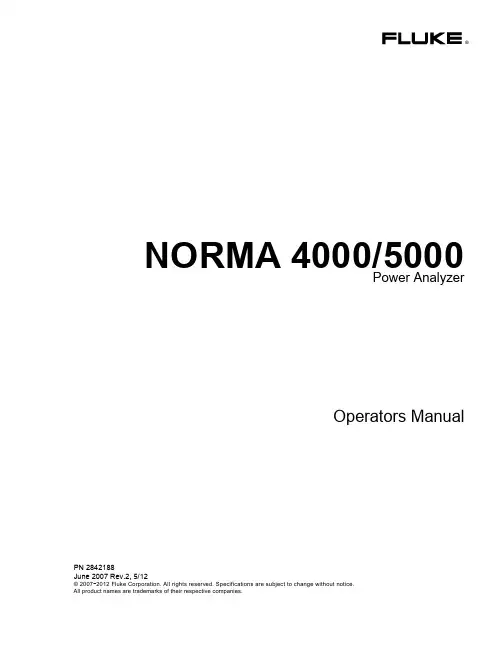
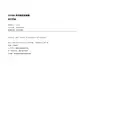
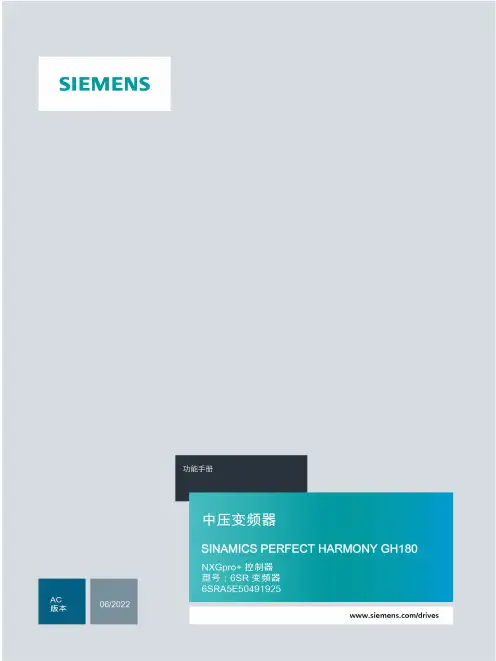
F1知识F1各车队的基本概况F1目前共有10支车队,其基本概况如下:法拉利车队(Ferrari):首次参赛:1950年车队冠军次数:13车手冠军次数:13分站赛胜利次数:160首发次数:158最快圈速次数:159参赛次数:671车队总积分:30405车队经理:让-托德赛车基本情况:底盘:F2004-GA引擎:法拉利052 V10轮胎:普利斯通车手:迈-舒马赫,巴里切罗迈凯伦车队(West McLaren):首次参赛:1966年车队冠军次数:8车手冠军次数:11分站赛胜利次数:135首发次数:122最快圈速次数:109参赛次数:26495车队总积分:544车队经理:朗-丹尼斯底盘:MP-18引擎:奔驰FO110J V10轮胎:米其林车手:库尔特哈德 莱库宁威廉姆斯车队(BMW Williams):首次参赛:1973年车队冠军次数:9车手冠军次数:7分站赛胜利次数:108首发次数:119最快圈速次数:122参赛次数:21975车队总积分:413车队经理:弗兰克-威廉姆斯赛车基本情况:威廉姆斯FW25引擎:宝马P83 V10轮胎:米其林车手:拉尔夫-舒马赫,胡安-帕布罗-蒙托亚雷诺车队(Renault):首次参赛:1977年车队冠军次数:0车手冠军次数:0分站赛胜利次数:15首发次数:31最快圈速次数:18参赛次数:141车队总积分:355车队经理:弗拉维奥-布里亚托尔赛车基本情况:雷诺R203引擎:雷诺RS23 V10轮胎:米其林车手:特鲁利,阿隆索索伯车队(Sauber Petronas):首次参赛:1993年车队冠军次数:0车手冠军次数:0分站赛胜利次数:0首发次数:0最快圈速次数:0参赛次数:164车队总积分:123车队经理:彼得-索伯赛车基本情况:索伯C22引擎:佩特洛纳斯0A V10轮胎:普利斯通车手:费斯切拉、马萨乔丹车队(Jordan):首次参赛:1991年车队冠军次数:0车手冠军次数:0分站赛胜利次数:3首发次数:2最快圈速次数:2参赛次数:198 车队总积分:271车队经理:埃迪-乔丹赛车:乔丹EJ13引擎:本田V10 RA002E轮胎:普利斯通车手:海德菲尔德、潘塔诺美洲虎车队(Jaguar Racing):首次参赛:2000年车队冠军次数:0车手冠军次数:0分站赛胜利次数:0首发次数:0最快圈速次数:0参赛次数:21车队总积分:50车队经理:尼基-劳达赛车:美洲虎R4引擎:福特-科斯沃斯CR4 V10 轮胎:米其林车手:韦伯,克莱恩英美车队(B A R):首次参赛:1999年车队冠军次数:0车手冠军次数:0分站赛胜利次数:0首发次数:0最快圈速次数:0参赛次数:68车队总积分:44车队经理:大卫-理察兹赛车:英美005引擎:本田RA003E V10轮胎:普利斯通车手:巴顿、佐藤琢磨丰田车队(TOYOTA):首次参赛:2002年车队冠军次数:0车手冠军次数:0分站赛胜利次数:0首发次数:0最快圈速次数:0参赛次数:17车队总积分:2车队经理:奥弗-安德森赛车:丰田TF103引擎:丰田RVX03 V10轮胎:米其林车手:潘尼斯,马塔米纳尔迪车队(Minardi):首次参赛:1985年车队冠军次数:0车手冠军次数:0分站赛胜利次数:0首发次数:0最快圈速次数:0参赛次数:288车队总积分:29车队经理:保罗-斯托达特赛车:KL米纳尔迪PS03引擎:ASIATECH AT03 V10轮胎:米其林车手:布鲁尼、鲍姆加特纳-----------------------------------------------------------------------------------------------------如何观看F1比赛F1比赛用的赛场一般为环形,赛道宽7-11米,每圈长3-7千米,每次比赛总赛程大约为305-320千米,为防止车速过快而设有众多弯道,同时也更加考验车手的驾驶技术和赛车的性能。